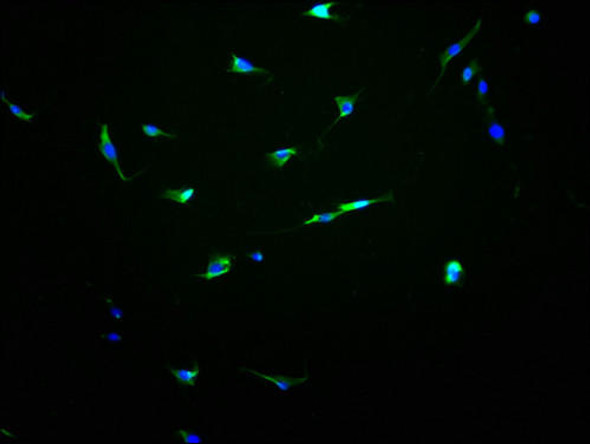Description
| Antibody Name: | GPR39 Antibody (PACO19738) |
| Antibody SKU: | PACO19738 |
| Size: | 50ul |
| Host Species: | Rabbit |
| Tested Applications: | ELISA, WB |
| Recommended Dilutions: | ELISA:1:1000-1:2000, WB:1:200-1:1000 |
| Species Reactivity: | Human |
| Immunogen: | Synthetic peptide of human GPR39 |
| Form: | Liquid |
| Storage Buffer: | -20°C, pH7.4 PBS, 0.05% NaN3, 40% Glycerol |
| Purification Method: | Antigen affinity purification |
| Clonality: | Polyclonal |
| Isotype: | IgG |
| Conjugate: | Non-conjugated |
 | Gel: 8%SDS-PAGE, Lysate: 40 μg, Lane 1-2: A431 cells, K562 cells, Primary antibody: PACO19738(GPR39 Antibody) at dilution 1/200, Secondary antibody: Goat anti rabbit IgG at 1/8000 dilution, Exposure time: 5 minutes. |
| Background: | G-protein coupled receptor 39 is a protein that in humans is encoded by the GPR39 gene. The predicted 453-amino acid, GPR39 protein contains the 7 transmembrane domains characteristic of GPCRs. By sequence comparison with other GPCRs, the protein sequence of GPR39 is 27% and 32% identical to that of GSHR and neurotensin receptor-1, respectively. Northern blot analysis revealed that GPR39 is expressed widely as a 1.8- to 2-kb mRNA. A 3-kb transcript is present on Northern blots of some tissues, either in addition to the smaller mRNA or as the only hybridizing band. |
| Synonyms: | G protein-coupled receptor 39 |
| UniProt Protein Function: | GPR39: Zn(2+) acts as a agonist. This receptor mediates its action by association with G proteins that activate a phosphatidylinositol-calcium second messenger system. Its effect is mediated mainly through G(q)-alpha and G(12)/G(13) proteins. Involved in regulation of body weight, gastrointestinal mobility, hormone secretion and cell death. Belongs to the G-protein coupled receptor 1 family.Protein type: Membrane protein, multi-pass; Receptor, GPCR; GPCR, family 1; Membrane protein, integralChromosomal Location of Human Ortholog: 2q21-q22Cellular Component: integral to plasma membrane; plasma membrane |
| UniProt Protein Details: | |
| NCBI Summary: | This gene is a member of the ghrelin receptor family and encodes a rhodopsin-type G-protein-coupled receptor (GPCR). The encoded protein is involved in zinc-dependent signaling in epithelial tissue in intestines, prostate and salivary glands. The protein may also be involved in the pathophysiology of depression. [provided by RefSeq, Jun 2016] |
| UniProt Code: | O43194 |
| NCBI GenInfo Identifier: | 3913748 |
| NCBI Gene ID: | 2863 |
| NCBI Accession: | O43194.1 |
| UniProt Secondary Accession: | O43194,Q08AS2, Q53R01, B2RC12, B6V9G4 |
| UniProt Related Accession: | O43194 |
| Molecular Weight: | 51,329 Da |
| NCBI Full Name: | G-protein coupled receptor 39 |
| NCBI Synonym Full Names: | G protein-coupled receptor 39 |
| NCBI Official Symbol: | GPR39 |
| NCBI Official Synonym Symbols: | |
| NCBI Protein Information: | G-protein coupled receptor 39 |
| UniProt Protein Name: | G-protein coupled receptor 39 |
| UniProt Synonym Protein Names: | |
| Protein Family: | G-protein coupled receptor |
| UniProt Gene Name: | GPR39 |
| UniProt Entry Name: | GPR39_HUMAN |






